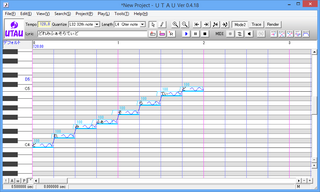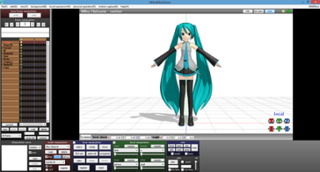
Vocaloid is a singing voice synthesizer software product. Its signal processing part was developed through a joint research project between Yamaha Corporation and the Music Technology Group in Universitat Pompeu Fabra, Barcelona. The software was ultimately developed into the commercial product "Vocaloid" that was released in 2004.

Actroid is a type of android with strong visual human-likeness developed by Osaka University and manufactured by Kokoro Company Ltd.. It was first unveiled at the 2003 International Robot Exhibition in Tokyo, Japan. Several different versions of the product have been produced since then. In most cases, the robot's appearance has been modeled after an average young woman of Japanese descent.

The National Institute of Advanced Industrial Science and Technology, or AIST, is a Japanese research facility headquartered in Tokyo, and most of the workforce is located in Tsukuba Science City, Ibaraki, and in several cities throughout Japan. The institute is managed to integrate scientific and engineering knowledge to address socio-economic needs. It became a newly designed legal body of Independent Administrative Institution in 2001, remaining under the Ministry of Economy, Trade and Industry.

In Japan, popular robots include humanoid entertainment robots, androids, animal robots, social robots, guard robots, and many more. Each type has a variety of characteristics.

The P series is a series of prototype humanoid robots developed by Honda between 1993 and 2000. They were preceded by the Honda E series and followed by the ASIMO series, then the world's most advanced humanoid robots. Honda Motor's President and CEO Hiroyuki Yoshino, at the time, described Honda's humanoid robotics program as consistent with its direction to enhance human mobility.
The Humanoid Robotics Project (HRP) is a project for development of general domestic helper robots, sponsored by Japan's Ministry of Economy, Trade and Industry (METI) and New Energy and Industrial Technology Development Organization (NEDO), spearheaded by Kawada Industries and supported by the National Institute of Advanced Industrial Science and Technology (AIST) and Kawasaki Heavy Industries, Inc. The HRP series also goes by the name Promet. The HRP should not be confused with the HOAP series, which is manufactured by Fujitsu.

Hatsune Miku, officially code-named CV01, is a Vocaloid software voicebank developed by Crypton Future Media and its official anthropomorphic mascot character, a 16-year-old girl with long, turquoise twintails. Miku's personification has been marketed as a virtual idol, and has performed at live virtual concerts onstage as an animated projection.

Megurine Luka, codenamed "CV03", is a Vocaloid software developed by Crypton Future Media, headquartered in Sapporo, Japan. Its official moe anthropomorphism is a 20-year-old woman. She uses Yamaha Corporation's Vocaloid 2 and Vocaloid 4 singing synthesizer technology. Her voice is sampled from Yū Asakawa. She has performed alongside other Vocaloids at live concerts onstage as an animated hologram projection.
Crypton Future Media, Inc., or simply Crypton, is a Japanese media company based in Sapporo, Japan. It develops, imports, and sells products for music, such as sound generator software, sampling CDs and DVDs, and FX and BGM libraries. The company also provides services of online shopping, online community, and mobile content.

UTAU is a Japanese singing synthesizer application created by Ameya/Ayame (飴屋/菖蒲). This program is similar to the VOCALOID software, with the difference being it is shareware instead of under a third party licensing.

AH-Software is the software brand of AHS Co., Ltd., an importer of digital audio workstations and encoders in Tokyo, Japan. It is also known as the developer of Voiceroid and a number of Vocaloid voicebanks.

MikuMikuDance is a freeware animation program that lets users animate and create computer-animated films, originally produced for the Japanese Vocaloid voice synthesizer software voicebank Hatsune Miku, the first member of the Character Vocal series created by Crypton Future Media. The program itself was programmed by Yu Higuchi (HiguchiM) and has gone through significant upgrades since its creation. Its production was made as part of the VOCALOID Promotion Video Project (VPVP).

OpenRTM-aist is a software platform developed on the basis of the RT middleware standard. OpenRTM-aist is developed by National Institute of Advanced Industrial Science and Technology which also contributes to definition of the RT-middleware standard.
Vocaloid is a singing voice synthesizer and the first engine released in the Vocaloid series. It was succeeded by Vocaloid 2. This version was made to be able to sing both English and Japanese.

Vocaloid 2 is a singing voice synthesizer and the successor to the Vocaloid voice synthesizer application by Yamaha. Unlike the first engine, Vocaloid 2 based its output on vocal samples, rather than voice analysis. The synthesis engine and the user interface were completely revamped, with Japanese Vocaloids possessing a Japanese interface, as opposed to the previous version, which used English for both versions. It is noteworthy for introducing the popular character Hatsune Miku. It was succeeded by Vocaloid 3.

Vocaloid 3 is a singing voice synthesizer and successor to Vocaloid 2 in the Vocaloid series. This version of the software is a much more expansive version, containing many new features, three new languages and many more vocals than past software versions combined. It was succeeded by Vocaloid 4.

Vocaloid 4 is a singing voice synthesizer and successor to Vocaloid 3 in the Vocaloid series. It was succeeded by Vocaloid 5.

Kagamine Rin & Len, officially code-named CV02, are a pair of Vocaloid software voicebanks developed by Crypton Future Media, headquartered in Sapporo, Japan. Their official moe anthropomorphism consists of a pair of twin 14 year old singers, a boy and a girl, respectively named Len and Rin. They use Yamaha Corporation's Vocaloid 2 and Vocaloid 4 voice synthesizing technology. Their voices are samples of voice actress Asami Shimoda. They have performed at live concerts together, as they are each other's mirrors.

Ribo is the first social humanoid robot which can speak in Bengali. Ribo was created by RoboSUST, a robotics group of Shahjalal University of Science & Technology, Bangladesh. The team was supervised by Muhammed Zafar Iqbal. Bangladesh Science Fiction Society funded for making this humanoid robot Ribo. Ribo was first appeared in public on 11 December 2015 in a Science Fiction Festival held at the Public Library, Shahbag.

















